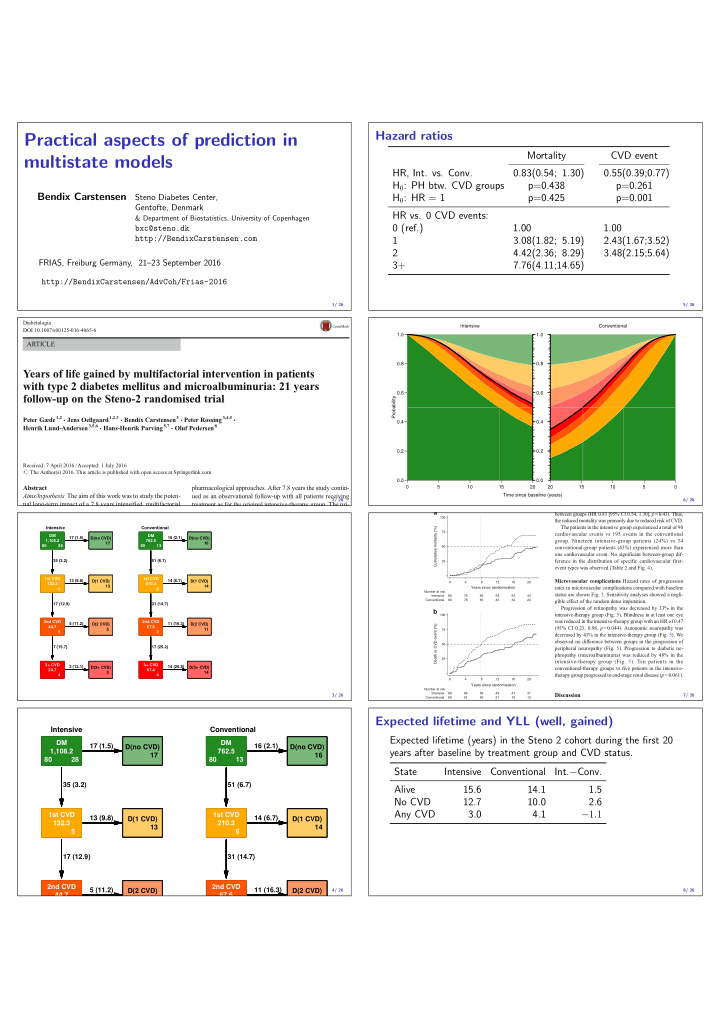



Hazard ratios Practical aspects of prediction in Mortality CVD event multistate models HR, Int. vs. Conv. 0.83(0.54; 1.30) 0.55(0.39;0.77) H 0 : PH btw. CVD groups p=0.438 p=0.261 Bendix Carstensen Steno Diabetes Center, H 0 : HR = 1 p=0.425 p=0.001 Gentofte, Denmark HR vs. 0 CVD events: & Department of Biostatistics, University of Copenhagen 0 (ref.) 1.00 1.00 bxc@steno.dk http://BendixCarstensen.com 1 3.08(1.82; 5.19) 2.43(1.67;3.52) 2 4.42(2.36; 8.29) 3.48(2.15;5.64) FRIAS, Freiburg Germany, 21–23 September 2016 3+ 7.76(4.11;14.65) http://BendixCarstensen/AdvCoh/Frias-2016 1/ 26 5/ 26 Diabetologia Intensive Conventional DOI 10.1007/s00125-016-4065-6 1.0 1.0 ARTICLE 0.8 0.8 Years of life gained by multifactorial intervention in patients with type 2 diabetes mellitus and microalbuminuria: 21 years 0.6 0.6 follow-up on the Steno-2 randomised trial Probability Peter Gæde 1,2 & Jens Oellgaard 1,2,3 & Bendix Carstensen 3 & Peter Rossing 3,4,5 & 0.4 0.4 Henrik Lund-Andersen 3,5,6 & Hans-Henrik Parving 5,7 & Oluf Pedersen 8 0.2 0.2 Received: 7 April 2016 /Accepted: 1 July 2016 # The Author(s) 2016. This article is published with open access at Springerlink.com 0.0 0.0 0 5 10 15 20 20 15 10 5 0 Abstract pharmacological approaches. After 7.8 years the study contin- Aims/hypothesis The aim of this work was to study the poten- Time since baseline (years) ued as an observational follow-up with all patients receiving 2/ 26 6/ 26 tial long-term impact of a 7.8 years intensified, multifactorial treatment as for the original intensive-therapy group. The pri- a between groups (HR 0.83 [95% CI 0.54, 1.30], p =0.43). Thus, 100 the reduced mortality was primarily due to reduced risk of CVD. Intensive Conventional Cumulative mortality (%) The patients in the intensive group experienced a total of 90 75 cardiovascular events vs 195 events in the conventional DM DM DM DM DM DM 17 (1.5) D(no CVD) D(no CVD) D(no CVD) 16 (2.1) D(no CVD) D(no CVD) D(no CVD) 1,108.2 1,108.2 1,108.2 762.5 762.5 762.5 group. Nineteen intensive-group patients (24%) vs 34 17 17 17 16 16 16 80 28 80 28 80 28 80 13 80 13 80 13 50 conventional-group patients (43%) experienced more than one cardiovascular event. No significant between-group dif- 35 (3.2) 51 (6.7) 25 ference in the distribution of specific cardiovascular first- event types was observed (Table 2 and Fig. 4). 1st CVD 1st CVD 1st CVD 1st CVD 1st CVD 1st CVD 13 (9.8) 14 (6.7) Microvascular complications Hazard rates of progression D(1 CVD) D(1 CVD) D(1 CVD) D(1 CVD) D(1 CVD) D(1 CVD) 0 4 8 12 16 20 132.3 132.3 132.3 210.3 210.3 210.3 13 13 13 14 14 14 Years since randomisation rates in microvascular complications compared with baseline 5 5 5 6 6 6 Number at risk status are shown Fig. 3. Sensitivity analyses showed a negli- Intensive 80 76 66 58 54 43 Conventional 80 78 65 45 34 24 gible effect of the random dates imputation. 17 (12.9) 31 (14.7) Progression of retinopathy was decreased by 33% in the b intensive-therapy group (Fig. 5). Blindness in at least one eye 100 2nd CVD 2nd CVD 2nd CVD 2nd CVD 2nd CVD 2nd CVD was reduced in the intensive-therapy group with an HR of 0.47 5 (11.2) D(2 CVD) D(2 CVD) D(2 CVD) 11 (16.3) D(2 CVD) D(2 CVD) D(2 CVD) Death or CVD event (%) 44.7 44.7 44.7 67.6 67.6 67.6 (95% CI 0.23, 0.98, p =0.044). Autonomic neuropathy was 5 5 5 11 11 11 75 5 5 5 2 2 2 decreased by 41% in the intensive-therapy group (Fig. 5). We observed no difference between groups in the progression of 50 7 (15.7) 17 (25.2) peripheral neuropathy (Fig. 5). Progression to diabetic ne- phropathy (macroalbuminuria) was reduced by 48% in the 25 intensive-therapy group (Fig. 5). Ten patients in the 3+ CVD 3+ CVD 3+ CVD 3+ CVD 3+ CVD 3+ CVD 3 (12.1) 14 (20.8) D(3+ CVD) D(3+ CVD) D(3+ CVD) D(3+ CVD) D(3+ CVD) D(3+ CVD) conventional-therapy groups vs five patients in the intensive- 24.7 24.7 24.7 67.4 67.4 67.4 3 3 3 14 14 14 4 4 4 4 4 4 therapy group progressed to end-stage renal disease ( p =0.061). 0 4 8 12 16 20 Years since randomisation Number at risk Intensive 80 66 56 49 41 31 Discussion 3/ 26 7/ 26 Conventional 80 61 40 27 18 13 Expected lifetime and YLL (well, gained) Intensive Conventional Expected lifetime (years) in the Steno 2 cohort during the first 20 DM DM DM DM DM DM 17 (1.5) 16 (2.1) D(no CVD) D(no CVD) D(no CVD) D(no CVD) D(no CVD) D(no CVD) 1,108.2 1,108.2 1,108.2 762.5 762.5 762.5 years after baseline by treatment group and CVD status. 17 17 17 16 16 16 80 28 80 28 80 28 80 13 80 13 80 13 State Intensive Conventional Int. − Conv. 35 (3.2) 51 (6.7) Alive 15.6 14.1 1.5 No CVD 12.7 10.0 2.6 Any CVD 3.0 4.1 − 1 . 1 1st CVD 1st CVD 1st CVD 1st CVD 1st CVD 1st CVD 13 (9.8) 14 (6.7) D(1 CVD) D(1 CVD) D(1 CVD) D(1 CVD) D(1 CVD) D(1 CVD) 132.3 132.3 132.3 210.3 210.3 210.3 13 13 13 14 14 14 5 5 5 6 6 6 17 (12.9) 31 (14.7) 2nd CVD 2nd CVD 2nd CVD 2nd CVD 2nd CVD 2nd CVD 5 (11.2) 11 (16.3) D(2 CVD) D(2 CVD) D(2 CVD) D(2 CVD) D(2 CVD) D(2 CVD) 4/ 26 8/ 26 44.7 44.7 44.7 67.6 67.6 67.6 5 5 5 11 11 11
Recommend
More recommend